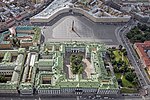Western Military District

The Western Military District (Russian: Западный военный округ) is a military district of Russia. It is one of the five military districts of the Russian Armed Forces, with its jurisdiction primarily within the western central region of European Russia. The Western Military District was created as part of the 2008 military reforms, and founded by Presidential Decree №1144 signed on September 20, 2010, as an amalgamation of the Moscow Military District, Leningrad Military District and Kaliningrad Special Region. The district began operation on October 20, 2010, under the command of Colonel-General Valery Gerasimov. The Western Military District is the second smallest military district in Russia by geographic size. The district contains 26 federal subjects of Russia: Belgorod Oblast, Bryansk Oblast, Ivanovo Oblast, Kaliningrad Oblast, Kaluga Oblast, Karelia, Kostroma Oblast, Kursk Oblast, Leningrad Oblast, Lipetsk Oblast, Moscow, Moscow Oblast, Nizhny Novgorod Oblast, Novgorod Oblast, Oryol Oblast, Pskov Oblast, Ryazan Oblast, Saint Petersburg, Smolensk Oblast, Tambov Oblast, Tver Oblast, Tula Oblast, Vladimir Oblast, Vologda Oblast, Voronezh Oblast, Yaroslavl Oblast. On 1 December 2014, the Arctic Joint Strategic Command was split off from the Western Military District, removing Arkhangelsk Oblast, Murmansk Oblast, Komi Republic, and the Nenets Autonomous Okrug, as well as the Russian Navy's Baltic Fleet and Northern Fleet, from the district's command.The Western Military District is headquartered in the General Staff Building in Saint Petersburg, and its current district commander is Colonel-General Alexander Zhuravlyov, who has held the position since November 2018.
Excerpt from the Wikipedia article Western Military District (License: CC BY-SA 3.0, Authors, Images).Western Military District
Большая Морская улица, Saint Petersburg
Geographical coordinates (GPS) Address Nearby Places Show on map
Geographical coordinates (GPS)
| Latitude | Longitude |
|---|---|
| N 59.9381 ° | E 30.3172 ° |
Address
Арка Главного штаба
Большая Морская улица
191186 Saint Petersburg (Palace District)
Saint Petersburg, Russia
Open on Google Maps









